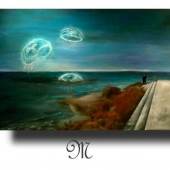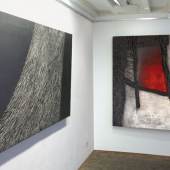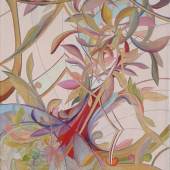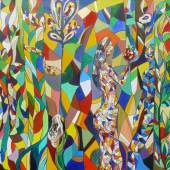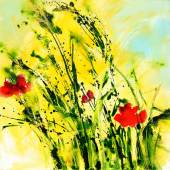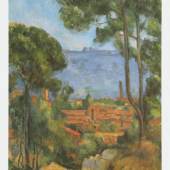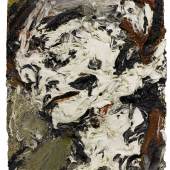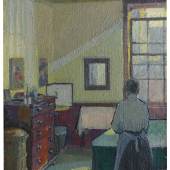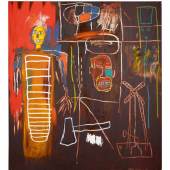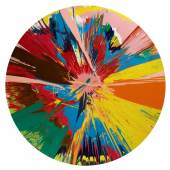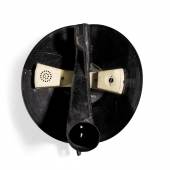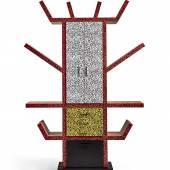Sotheby’s London
David Bowie’s Personal Art Collection to be Unveiled for the First Time
-
Auktion10.11.2016 - 11.11.2016
Cécile Verdier, Co-Head of 20th Century Design at Sotheby’s, said: “The works produced by the historical avant-garde design collaborative Memphis Milano, led by Ettore Sottsass, could not have found a more receptive and tuned-in audience than David Bowie. This is design with no limits and no boundaries. When you look at a piece of Memphis design, you see their unconventionality, the kaleidoscope of forms and patterns; the vibrant contrasting colours that really shouldn’t work but really do.”
A Glimpse inside the Collection
Auerbach
“My God, yeah! I want to sound like that looks” – David Bowie on Frank Auerbach’s work, quoted in the New York Times, 1998. Bowie loved the rich, sculptural effects of Auerbach’s paintings (“I find his kind of bas- relief way of painting extraordinary. Sometimes I’m not really sure if I’m dealing with sculpture or painting”), and clearly felt a deep affinity with the artist, whose work could provoke in him a whole gamut of reactions: “It will give spiritual weight to my angst. Some mornings I’ll look at it and go, “Oh, God, yeah! I know!’’ But that same painting, on a different day, can produce in me an incredible feeling of the triumph of trying to express myself as an artist.” [Ibid] Head of Gerda Boehm, a portrait of the artist’s cousin, was last exhibited at the Royal Academy, when Bowie lent the work to Auerbach’s much- heralded retrospective in 2001.
Gilman
Harold Gilman’s painting, an essay in stillness, of the remains of the day, appears at first glance to be anything but revolutionary. But in the context of British art in the early 20th century, it is, in its own quiet and covert way, very radical. This was a new kind of subject, a suburban lodger and part-time charlady, lost in thought in a nondescript room in an ordinary London house. For art to be modern, artists like Gilman demanded that it should be concerned with the everyday life of the city, with the peripheral and unseen, with the working classes. All of this must not have been lost on Bowie, a boy born in Brixton just after the Second World War, when much of London’s housing stock was still as it was in the early part of the century – grand Georgian houses subdivided into flats and bedsits, with tall thin sash windows, linoleum floors and a stove for heat.
Lanyon
Witness is one of three works by Peter Lanyon that Bowie loaned to the artist’s retrospective at Tate St Ives in 2010. Lanyon painted Witness two years after he had first taken to the skies in a glider. This new activity allowed him to see the Cornish landscape from a radically different perspective and to bring bigger, more elemental forces into his painting, becoming “like the mountaineer who cannot see the clouds without feeling the lift inside them.” This is a painting of American scale and ambition, painted in a converted sail-loft in a small fishing town on the western-most tip of England.
Basquiat
“I feel the very moment of his brush or crayon touching the canvas. There is a burning immediacy to his ever evaporating decisions that fires the imagination ten or fifteen years on, as freshly molten as the day they were poured onto the canvas” – David Bowie on Basquiat, Modern Painters, 1996. The Bowie-Basquiat connection is best known through the lens of Julian Schnabel’s 1996 film Basquiat, in which David played the role of the young artist’s mentor and collaborator, Andy Warhol. Air Power was acquired by Bowie the following year. “It comes as no surprise to learn that he [Basquiat] had a not-so-hidden ambition to be a rock musician, as his work relates to rock in ways that very few other visual artists get near.” – David Bowie on Basquiat, Modern Painters, 1996.
Hirst
Bursting with a magnificently dynamic energy in its pulsating kaleidoscope of reds, greens, blues and yellows, this is a vibrant and powerful example of Damien Hirst’s trademark ‘spin’ paintings. Hirst was one of only a handful of high-profile contemporary artists for whom Bowie publicly expressed his admiration, interviewing the ‘Young British Artist’ for Modern Painters in 1995. “He’s different. I think his work is extremely emotional, subjective, very tied up with his own personal fears – his fear of death is very strong – and I find his pieces moving and not at all flippant”, said Bowie in an interview with the New York Times.
Hazoumé
Beninese artist Romuald Hazoumé is probably best known for his sculptural assemblages of commonplace found objects, such as Alexandra. Much like Marcel Duchamp and his ‘Readymades’, Hazoumé appropriates familiar objects and reconfigures them, creating a dialogue between art history and the history of colonialism in Africa, as well as contemporary African politics, especially those surrounding oil.
Alexandra is indicative of Bowie’s far-reaching collecting interests, as well as his love of works with multiple layers of meaning and a sense of mischief and play. Bowie’s approach to contemporary African art – as with all other elements of the collection – was marked by a deep intellectual rigour, exemplified by his five- page review of the inaugural Johannesburg Biennale for Modern Painters in 1995.
-
Der deutsch-französische Krieg beeinflusst natürlich auch das künstlerische Leben...
-
11.12.2024Iconic Heuer Monaco Worn by Steve McQueen in LeMansRaces to Auction at Sotheby’s New York...
-
10.11.2016 - 11.11.2016Auktion »
KEY DATES:
Preview World Tour:
London: 20 July-9 August
Los Angeles: 20-21 September
New York: 26-29 September
Hong Kong: 12-15 OctoberThe Exhibition:
Bowie/Collector: 1–10 November
Sotheby’s New Bond Street, LondonThe Auctions:
Part I: Evening Auction of Modern and Contemporary Art, 10 November
Part II: Day Auction of Modern and Contemporary Art, 11 November
Part III: Post-Modernist Design: Ettore Sottsass and the Memphis Group, 11 November
